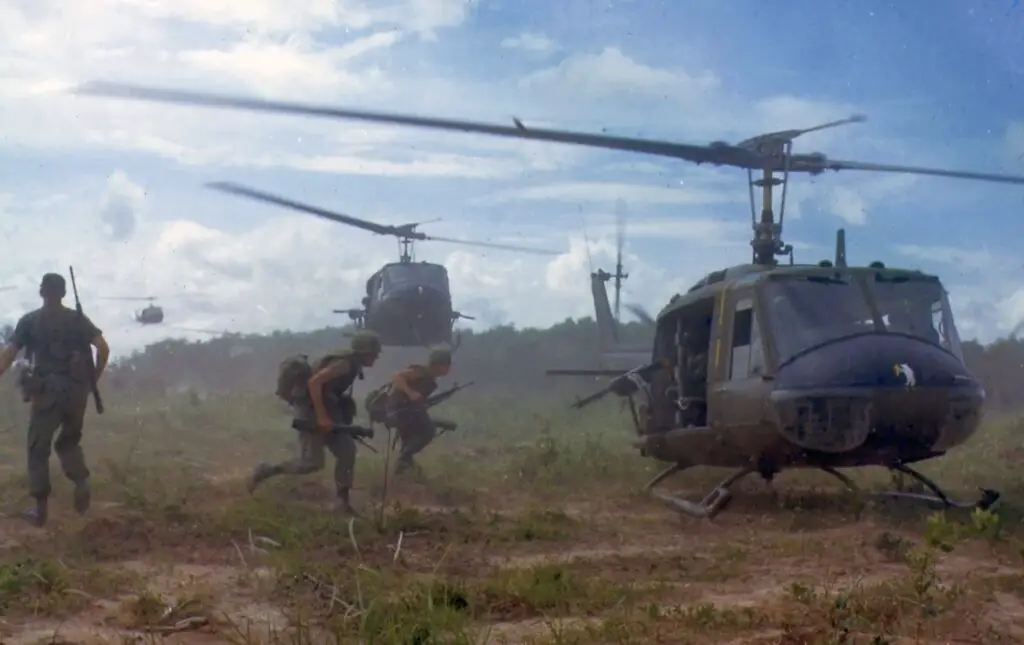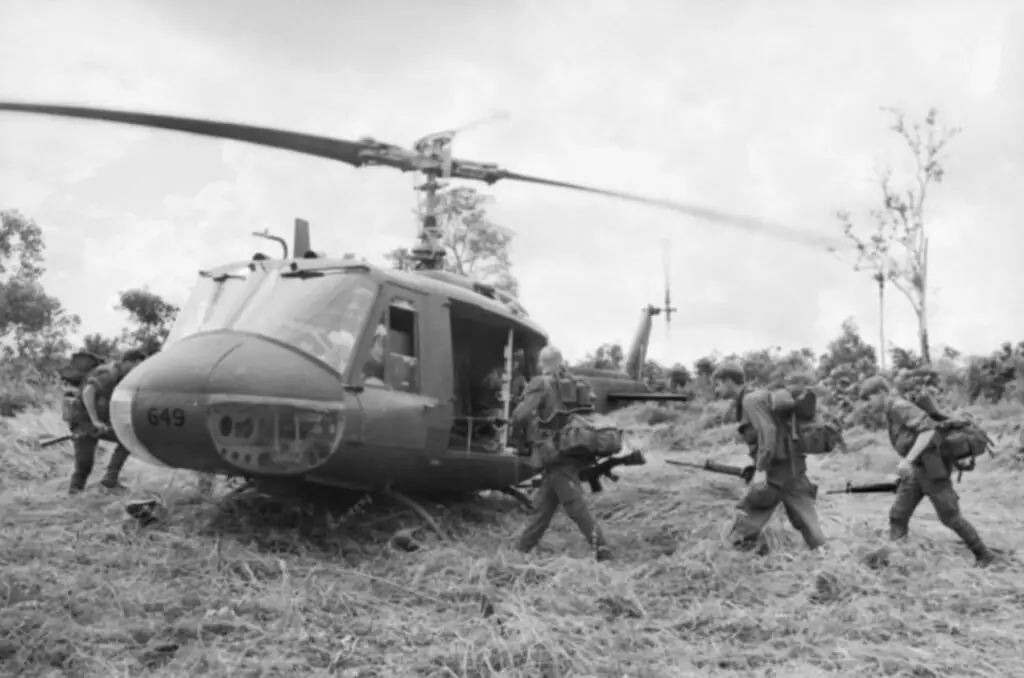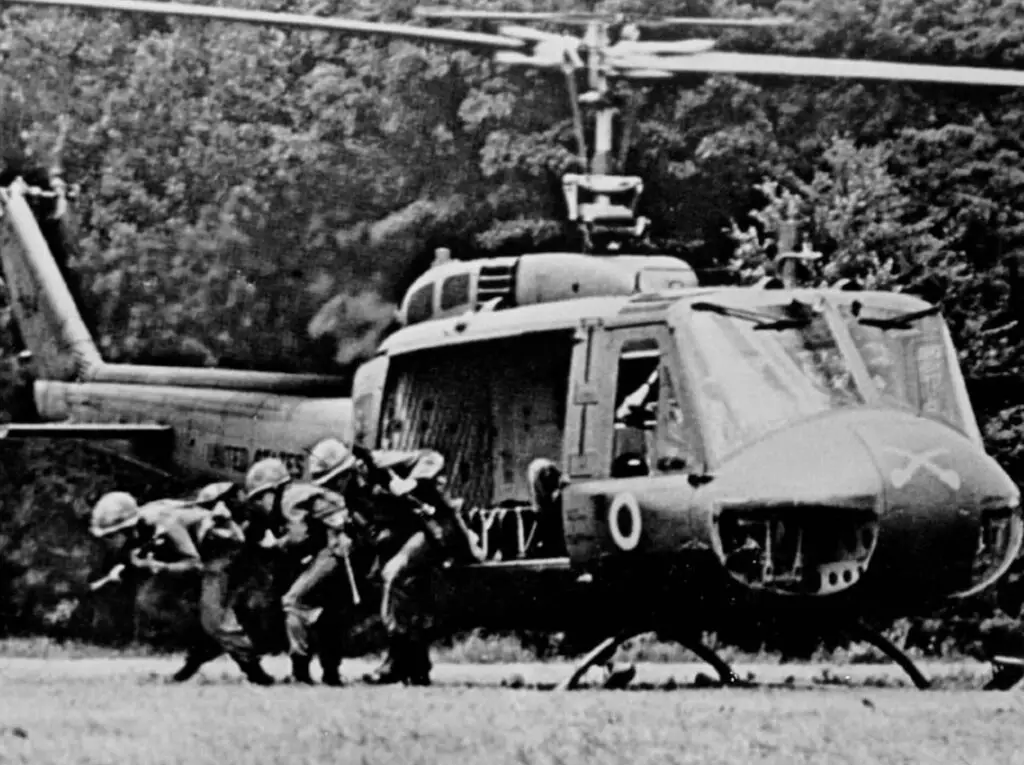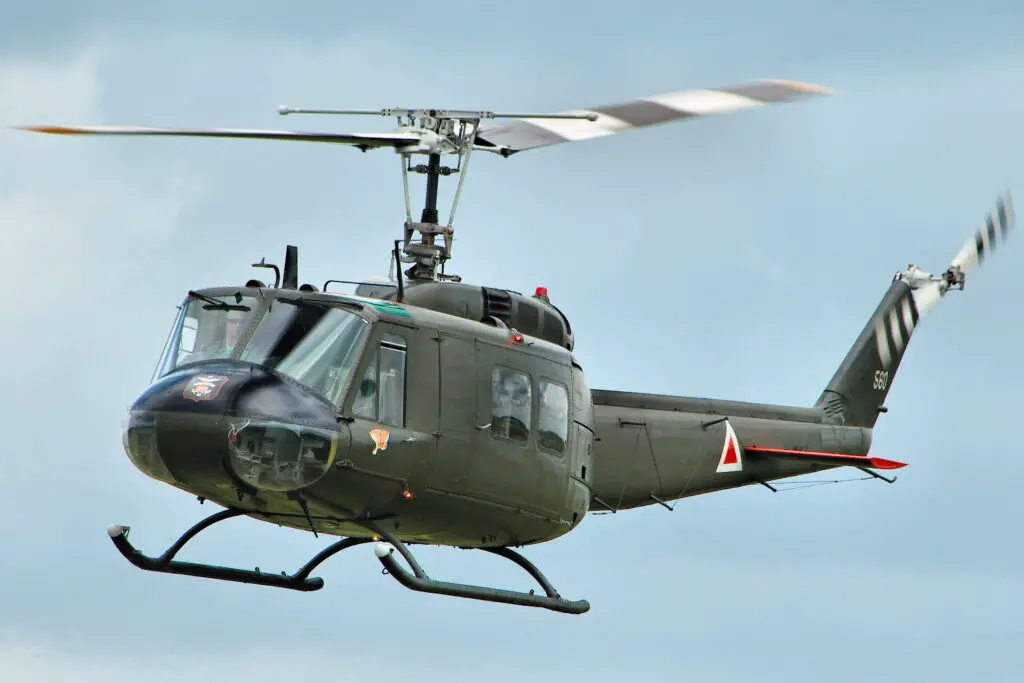The Bell UH-1 Iroquois, famously known as the “Huey,” rose into the skies as a mark of American innovation and quickly became the emblem of the Vietnam War. This helicopter redefined battlefield mobility, offering a previously unseen mix of versatility.
From transporting troops to serving as a medevac, the Huey was pivotal in shaping the outcomes of countless missions. Let’s explore how this innovative machine left its mark on history and became a symbol deeply ingrained in the memories of those who witnessed its capabilities.
Table of Contents
- The History of the Huey Helicopter
- The Huey’s Influence on Helicopter Design
- Soldiers’ Experience with the Huey
- Cultural Impact of the Huey
- Related Questions
The History of the Huey Helicopter
The Bell UH-1 Iroquois, more famously known as the “Huey,” took off into the skies as an emblem of American innovation. However, shortly after its debut, this chopper became the defining symbol of the Vietnam War. Let’s dive into how this happened, will we?
First off, the Huey was a game-changer from the get-go. Its introduction brought a new era of mobility and flexibility on the battlefield. Unlike before, troops could now be transported quickly across the challenging terrain of Vietnam, dropped into hot zones, or swiftly evacuated. This was a significant upgrade from relying on slower, more traditional methods. The Huey made the U.S. military more agile, a crucial advantage in the unpredictable environment of Vietnam.
But it wasn’t just about moving troops. The Huey was versatile. It served as a gunship, a medevac for the wounded, a cargo transporter, and a flying command center. Its adaptability made it essential for various missions, highlighting its importance in the U.S. military strategy. The mere sound of its blades became associated with hope for those on the ground. The Huey was your best bet for getting out if you were in a tight spot.
The Huey also took the media spotlight. As television became a household staple in the 1960s, images and footage of Hueys in action captivated audiences back home. They were seen airlifting soldiers, raining down firepower, and saving lives. This constant media presence etched the image of the Huey into the public conscience as a symbol of the U.S. involvement in Vietnam. It represented both the U.S. military’s technological might and the war’s challenging circumstances.
On a deeper level, the Huey symbolized the experiences of those who served in Vietnam. For veterans, the sound of a Huey can instantly transport them back to the jungles of Southeast Asia. It embodies the camaraderie, adrenaline, and uncertainties of their service. The Huey became more than a helicopter; it was a witness to the bravery, sacrifices, and complexities of the Vietnam War.
Its legacy endures, not just in military history but also in popular culture. From movies to documentaries and even in memorials, the Huey is portrayed as the iconic image of the Vietnam conflict. It’s fascinating how a piece of technology can transcend its initial purpose and become such a powerful symbol.
How did the Huey become a symbol of the Vietnam War, you ask? It was through its unprecedented versatility on the battlefield, its omnipresence in media, and its deep connection to the experiences of those who served. The Huey was not just a helicopter; it was the Vietnam War flying through time, carrying stories of courage and resilience.

The Huey’s Influence on Helicopter Design
Now, let’s explore how the Huey, a true icon of aviation, has influenced the design of future helicopters. Beyond its versatility and symbolic stature, the Huey introduced design elements that have become staples in the blueprint of modern helicopters.
One of Huey’s most influential design features is its rotor system. The Huey utilized a two-blade central rotor system that was simple yet effective, making it more reliable and easier to maintain than the more complex systems found on earlier helicopters. This emphasis on simplicity and reliability has been carried over to many modern helicopters, ensuring they can perform in various conditions without needing constant, complicated maintenance.
Another groundbreaking aspect was the Huey’s use of a turboshaft engine. This was a significant shift from the piston engines used in earlier helicopters. The turboshaft engine offered more power and was lighter, contributing to the Huey’s capability to fulfill various roles from cargo transport to medevac missions. Today, the turboshaft engine is a standard among helicopters, providing the necessary power and efficiency for various tasks.
The Huey’s cockpit design also made waves. It featured large windows that offered pilots unparalleled visibility, a critical factor in combat and rescue missions. Nearly all military and civilian helicopters have adopted this design element, recognizing the importance of visibility for safe and effective operation.
Perhaps one of the Huey’s most subtle yet impactful design influences is its modular approach to mission equipment. The Huey could be quickly configured with various weapons, medical equipment, or cargo transport apparatus, making it a highly adaptable aircraft. This modularity has become a key feature in the design of future helicopters, allowing for a wide range of missions with a single airframe by simply swapping out equipment.
The noise of the Huey’s blades chopping through the air became a symbol of hope for many and a sound of terror for others. This auditory signature highlighted the importance of sound in helicopter design. While modern helicopters haven’t eliminated noise, there has been an emphasis on designing more efficient rotor systems that produce different sound signatures, showing an evolution in how the auditory impact of a helicopter is considered in its design.
In wrapping up this exploration of the Huey’s lasting impact on helicopter design, it’s evident that the Huey played a pivotal role in transforming military operations and shaping the evolution of helicopter technology. From its rotor system and engine to its cockpit visibility and modular capabilities, the design elements pioneered by the Huey continue to influence the development of helicopters, ensuring its legacy flies on in the skies of today and tomorrow.

Soldiers’ Experience with the Huey
Continuing to introduce the Huey helicopter’s game-changing role on the battlefield, let’s dive deeper into the day-to-day lives of the soldiers who flew and maintained these iconic birds. Flying and maintaining a Huey was no small feat and required a combination of skill, dedication, and, quite frankly, nerves of steel.
Life in the Sky: Pilots and Crew Members
For pilots and their crews, the Huey was more than just a machine; it was a lifeline. Each mission, whether a medevac rescue, transport, or a combat assault, began with a meticulous pre-flight check. A pilot’s confidence in their Huey wasn’t just about the bird holding up mechanically; it was about knowing every nut and bolt, ensuring it could withstand the rigors of combat and the unforgiving terrain of places like Vietnam.
Imagine being a pilot or crew member, hearing the hum of the turboshaft engine in your ears, feeling the helicopter lift off, becoming part of the sky. For these soldiers, flying a Huey was the ultimate expression of freedom and responsibility. But it was also a constant battle against gravity, enemy fire, and the limits of human endurance.
Visibility in the cockpit was a double-edged sword. The expansive view allowed pilots to navigate the dense foliage and tricky landscapes of conflict zones but also exposed them to enemy fire. Every mission was a calculated risk, but the Huey’s agility and speed often gave its crew the upper hand.
Life on the Ground: Mechanics and Maintenance Crews
On the ground, the unsung heroes were the mechanics and maintenance crews, working tirelessly to keep the Hueys in the air. For them, the sound of a smooth-running engine was music to their ears, a sign of a job well done. These crews were often under tremendous pressure, working against the clock to repair and maintain helicopters with a supply chain that could best be described as unpredictable.
The Huey’s modular design was a blessing, allowing maintenance crews to swap out damaged parts quickly, but it also demanded a broad knowledge of the helicopter’s systems. Downtime wasn’t just a delay; it could mean the difference between life and death for soldiers awaiting extraction or urgent medical care.
A Brotherhood Forged in Adversity
Amid the chaos of war, a special bond formed among the Huey crews. Pilots, gunners, and mechanics shared an unspoken understanding, a mutual respect forged in the crucible of combat. This brotherhood was their armor against the uncertainty of each mission, the fear of not making it back, and the heartbreak of losing comrades.
For those flying and maintaining Hueys, their experiences were a relentless cycle of adrenaline, fear, and camaraderie. The Huey was their home, their weapon, and their guardian angel. Despite the constant threat of ambushes and mechanical failures, these soldiers pushed the limits of what was possible, changing the course of battles and saving countless lives.
Legacy Beyond the Battlefield
Today, the legacy of those who flew and maintained the Huey lives on, not just in military history but also in stories of bravery, innovation, and the human spirit. The Huey became more than a helicopter; it was a symbol of hope and a testament to the resilience of those who served.
Life for soldiers flying and maintaining Hueys was a complex tapestry of technological innovation, tactical mastery, and human resilience. Each day brought new challenges, but it also offered the opportunity to make a difference, to protect their fellow soldiers, and to participate in a chapter of history that would never be forgotten. While the roar of the Huey’s blades might have faded into silence, the memories and legacy of those who were part of its story continue to echo through time.

Cultural Impact of the Huey
When we examine what transformed the Huey helicopter into an iconic symbol of American culture, it’s not just about the mechanics or its roles; it’s also about the stories it tells, the innovation it brought into the limelight, and the sheer impact it had on shaping the perceptions of a whole generation.
First, let’s talk innovation. The Huey wasn’t just another chopper. Its introduction marked the dawn of a new era in aviation technology. The shift from piston to turboshaft engines wasn’t simply a technical upgrade—it was revolutionary. This leap in technology didn’t just mean more power; it signified reliability, a lifeline for those on the battlefield. Imagine being in the heat of battle, knowing your ride wasn’t just powerful but dependable. That’s what the Huey brought to the table.
But innovation didn’t stop under the hood. The cockpit of the Huey was designed with visibility in mind. Pilots sitting in a Huey had an unparalleled view of their surroundings, which was crucial for navigation and mission success, especially in the dense terrains of Vietnam. This design was not merely about aesthetics but survival.
Let’s not forget the sound – that distinct whoop-whoop that could be recognized miles away. This wasn’t just about the rotor system’s technicalities, as fascinating as they were in their simplicity and reliability. It was about the identity it carved. The sound of a Huey became synonymous with hope and dread, often in the same breath, a tangible reminder of the complexities of war.
Now, the heart and soul of the Huey are the people who lived and breathed these machines. The intricate relationship between the pilots, crew members, and their Huey was forged in the fires of conflict and camaraderie. Pre-flight checks were a ritual, a testament to the sacred bond between man and machine, where knowing your Huey inside and out could mean the difference between life and death.
The thrill and terror of flying a Huey in combat were unparalleled. Pilots and crew faced the harsh realities of war, from navigating through enemy fire to the risks posed by the very visibility that was their boon. Every flight was a dance with danger, a delicate balance between completing the mission and making it home.
Maintenance crews, the unsung heroes of this saga, faced their challenges with grit and dedication. The Huey’s modular design, while innovative, demanded a mastery from these teams to keep these birds in the sky. Their relentless efforts, often under extreme conditions, were a testament to their skill and determination.
Amidst the adrenaline and fear, a brotherhood was forged. These crews, bonded by their shared experiences, became a family. Their legacy is not just in the missions accomplished or the lives saved; it’s in the unbreakable spirit they embodied.
In closing, Huey’s journey from a military workhorse to an American cultural icon is a story of innovation, resilience, and humanity. Its impact reaches beyond its roles on the battlefield to touch the hearts and minds of those who witnessed its legacy. The Huey symbolizes not just American involvement in Vietnam but a time of transformation and hope against the backdrop of challenge and adversity.
The tapestry of Huey’s story is woven with threads of technological breakthroughs, human courage, and a legacy that continues to resonate with generations. The Huey remains a powerful symbol of American ingenuity and the unbreakable spirit of those who served with it. Indeed, it’s a story that captures the essence of an era, a testament to the enduring legacy of the Huey in American culture.

Huey’s compelling story weaves through the tapestry of military, cultural, and technological landscapes, leaving behind a legacy that still resonates today. Beyond its battlefield prowess, it became a symbol of hope, courage, and innovation, touching the lives of many.
The Huey’s distinctive sound, remarkable versatility, and the deep bond formed between it and its crew highlight the profound impact it had not just on warfare but also on the human spirit. As we reflect on Huey’s contributions, we see that they stand as a testament to American ingenuity and the bravery of those connected with it, ensuring that its legend will continue to soar in the hearts and minds of future generations.
Listen To Our Podcast About
What Made the Huey a Defining Icon of the Vietnam War?
Below or By clicking here.

At A Bus On A Dusty Road, we talk about history, travel, life, sailing, and ex-pat living. We are all about “Living Life As A Global Citizen.” We explore social, cultural, and economic issues and travel.
We would love to have you be part of our community. Sign up for our newsletter to keep up-to-date by clicking here. If you have any questions, you can contact me, Anita, by clicking here.
Listen to our Podcast called Dusty Roads. You can find it on all major podcast platforms. Try out listening to one of our podcasts by clicking here.
Subscribe to our A Bus On A Dusty Road YouTube Channel with great videos and information.
Related Questions
What U. S Companies Profited During The Vietnam War?
During the Vietnam War, many U.S. companies profited from the Vietnam war. Some of these companies were heading toward bankruptcy, but their involvement in the Vietnam war helped make them profitable. For many others, they earned millions of dollars each year in profits from the war that helped ensure they continued to be successful or even thriving companies.
By clicking here, you can discover What U. S Companies Profited During The Vietnam War?
Could America Have Won The Vietnam War?
America could not have won the Vietnam war as it never won the hearts and minds of the Vietnamese people. The Americans even had difficulty controlling the Vietnamese people in Southern Vietnam, as many were disillusioned with the Southern Vietnamese government. Ho Chi Minh, the leader of North Vietnam, fully understood that another foreign power would not control the Vietnamese heart and soul.
By clicking here, you can discover Could America Have Won The Vietnam War?
What Was The Main Reason For US Involvement In Vietnam?
The main reason for the involvement of the United States in the Vietnam War was the belief in the Domino theory; the Domino theory was a principle used to describe the effects on the world if Vietnam fell to communism. The idea was that if Vietnam became communist, the rest of Asia, New Zealand, and Australia would eventually become communist. At the time, American leaders felt they were fighting for the survival of democracy throughout the world.
By clicking here, you can learn more by reading What Was The Main Reason For U.S. Involvement In Vietnam?

